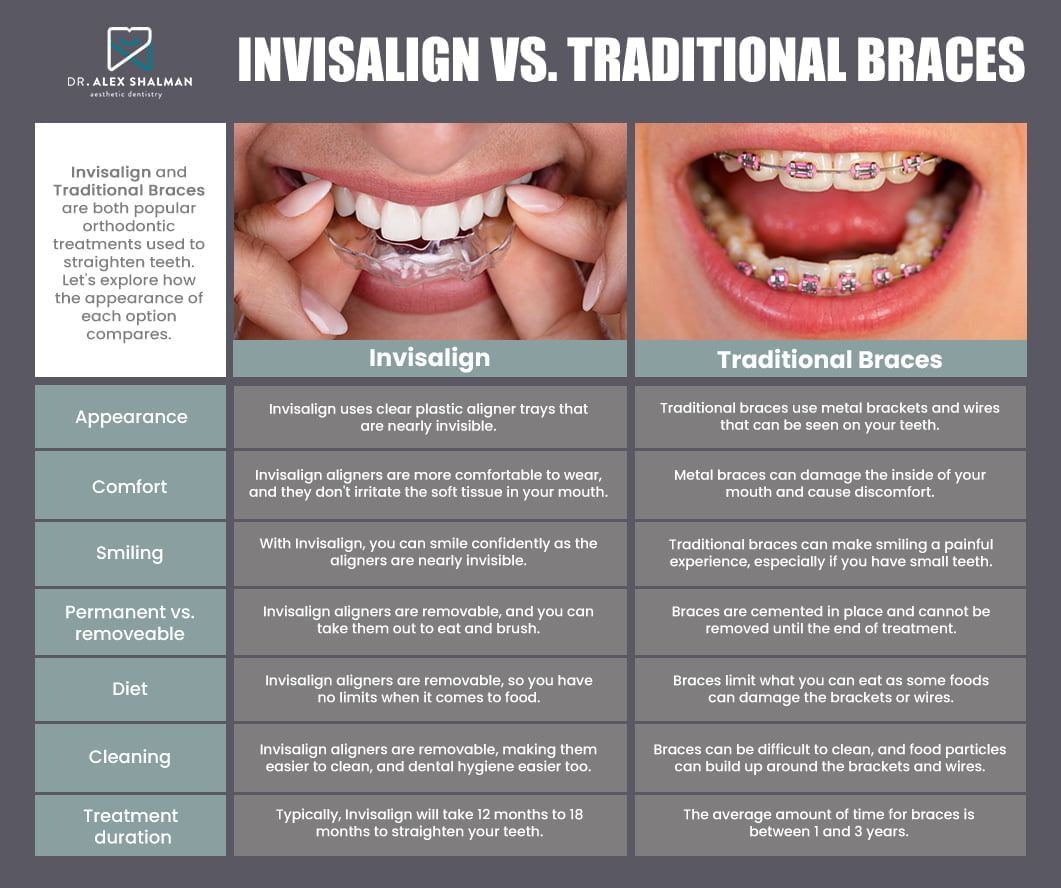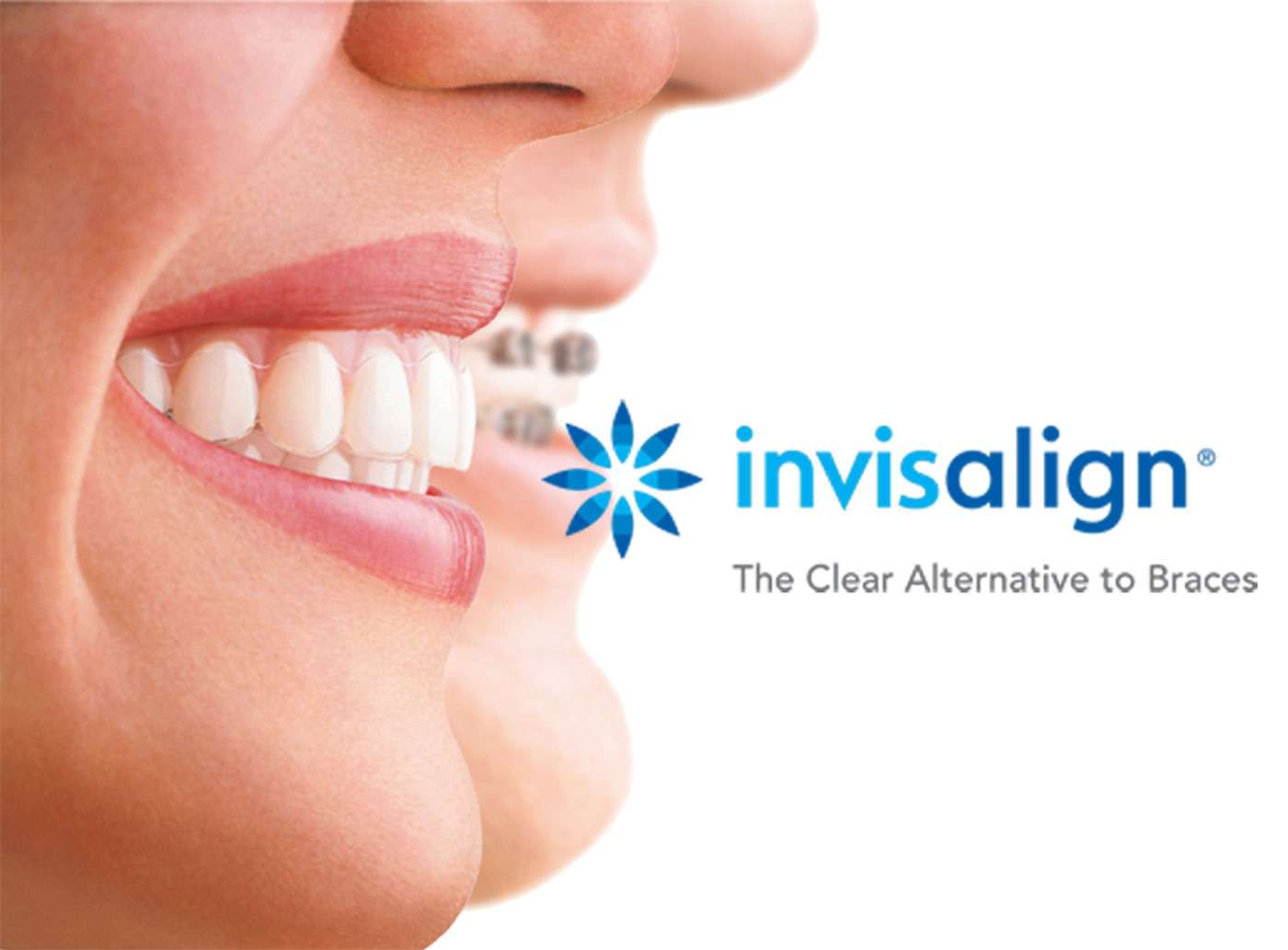Invisalign vs. Conventional Braces: Which Alternative Is Right for You?
When thinking about orthodontic treatment, the selection between Invisalign and traditional dental braces presents numerous essential factors that warrant careful examination. Invisalign provides a very discreet alternative with detachable aligners, while conventional dental braces offer an extra noticeable yet effective option for severe imbalance. Each alternative includes distinctive advantages and downsides related to aesthetic appeals, convenience, treatment period, and expense. Understanding these nuances is critical for making an informed choice that lines up with your personal choices and lifestyle. The question stays: which alternative will best satisfy your orthodontic demands and assumptions?
Review of Therapy Alternatives

In comparison, traditional braces include steel brackets and cables that are adhered to the teeth. This method applies constant stress over time to accomplish positioning. While reliable for complex orthodontic issues, standard dental braces call for regular check outs for changes and can pose challenges in preserving oral hygiene because of the trouble of cleansing about braces and cords.
Both options have their benefits, and the option typically depends upon details oral problems, way of life choices, and individual conformity. Eventually, getting in touch with an orthodontic specialist is crucial for determining the most suitable therapy strategy customized to private needs. Understanding the nuances of each alternative can significantly affect the total success of orthodontic therapy.
Aesthetic Considerations
A significant variable affecting the option between Invisalign and typical dental braces is the aesthetic appeal each therapy uses. Invisalign aligners are crafted from clear plastic, making them essentially unnoticeable when worn. This very discreet appearance is particularly interesting grownups and teenagers who might feel self-conscious concerning their orthodontic treatment. The ability to maintain an all-natural smile throughout the placement process can significantly enhance the person's self-confidence in professional and social setups.
In contrast, typical braces include metal brackets and cords, which can be more obvious. While improvements in orthodontic technology have brought about the development of smaller sized braces and tinted elastics, traditional dental braces still keep an even more conspicuous profile. For some people, the exposure of dental braces might discourage them from seeking essential therapy.
Eventually, the selection between Invisalign and conventional dental braces might rest on personal preferences pertaining to aesthetic appeals. People that focus on discernment typically favor Invisalign, while those that are much less worried concerning visibility may choose standard dental braces. Recognizing the visual effects of each option is important for making a notified choice that lines up with one's way of life and choices.
Comfort and Convenience

In regards to ease, Invisalign aligners are detachable, making it possible for people to appreciate their favored foods without constraint and keep ideal dental hygiene. Cleaning and flossing are streamlined, as the aligners can be obtained throughout these regimens, whereas standard braces require careful maneuvering around braces and cords.
In contrast, standard braces demand regular changes, making them less hassle-free for those with busy timetables. In general, the convenience and benefit of Invisalign make it an enticing option for several individuals looking for orthodontic treatment.
Therapy Period and Efficiency
While both Invisalign and conventional braces work in fixing oral imbalances, the duration of therapy can differ substantially between both options. Normally, Invisalign treatment can take anywhere from 12 to 18 months, depending upon the intricacy of the case. The clear aligners work by progressively shifting teeth into their preferred placements, and normal follow-ups with an orthodontist help make sure progression remains on track.
On the other hand, typical dental braces frequently need a longer dedication, generally varying from 18 months to 3 years. This is due to their fixed nature and making use of brackets and cables, which can be extra reliable for complex find out here now cases and severe misalignments (Invisalign). The treatment effectiveness of conventional braces is well-documented, as they enable accurate adjustments and greater control over tooth movement
Ultimately, the choice in between Invisalign and typical dental braces might pivot on both the expected treatment duration and the specific oral concerns available. Consulting with an orthodontist is vital, as they can supply tailored suggestions based on specific demands, making sure the selected method aligns with wanted end results and durations.
Price Comparison and Insurance Coverage Options
Price plays a substantial function in the decision-making process for people thinking about orthodontic treatment, whether going with Invisalign or standard braces. Generally, the expense of Invisalign ranges from $3,000 to $8,000, while typical braces typically set you back between $2,000 and $6,000. Variables influencing these costs include the intricacy of the situation, the duration of therapy, and geographical location.
Numerous oral insurance policy plans offer partial protection for orthodontic therapies, yet the specifics can vary widely. Normally, typical braces may be much more often covered by insurance policy strategies contrasted to Invisalign, which some insurers categorize as a cosmetic procedure.
Additionally, a number of orthodontic methods use adaptable layaway plan, making both therapy alternatives extra accessible. Patients should inquire about potential financing options and discounts for ahead of time settlements. Evaluating the complete price, consisting of insurance policy advantages and repayment plans, is important for making an informed decision that straightens with both visual preferences and try these out budget considerations.

Final Thought
In summary, the selection between Invisalign and traditional dental braces rests on numerous elements, consisting of aesthetic choices, comfort, therapy period, and expense. Invisalign supplies a discreet, detachable option that assists in oral health and dietary versatility, while typical dental braces may be better for complicated oral issues and usually come with a lower rate point. Eventually, assessment with an orthodontist is crucial to evaluate specific conditions and identify one of the most ideal treatment choice for achieving optimum oral alignment.
When considering orthodontic treatment, the choice between Invisalign and standard dental braces offers several important elements that merit cautious evaluation.Contrasting Invisalign and typical dental braces discloses distinctive therapy alternatives for orthodontic correction.While both Invisalign and traditional braces are effective in correcting dental misalignments, the duration of treatment can vary substantially in between the two choices.Cost plays a significant role in the decision-making procedure for people considering orthodontic treatment, whether opting for Invisalign or traditional page dental braces.In recap, the option between Invisalign and traditional dental braces pivots on several elements, including visual choices, comfort, therapy period, and expense.